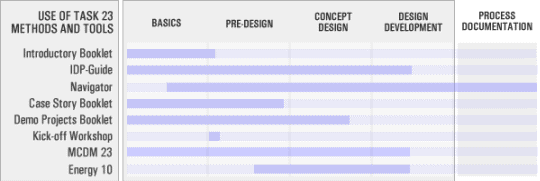To support design team during the integrated design process Task 23 experts developed a diversity of instruments. For each stage of the design process one or more instrument are available.

Following the time axis of the design process the following instruments can be applied:
BASICS (INITIATIVE, FEASIBILITY STUDY, PROGRAM OF REQUIREMENTS)
-
The stage of basics is the typical stage to initiate an integrated design process. The introductory booklet describes the integrated design process in general and gives a first impression of its benefits for a new design project. The initiator of the integrated design process within a design team can use it to inform the other team members (including the client).
-
If team members would like to learn more about the integrated design process they can consult the Integrated Design Process Guide. This guide can be helpful throughout the major part of the design process.
-
The Case Story Booklet and the Demo Projects Booklet show examples of buildings created through integrated design. They can be quite informative when discussing the initiative with the client. But also for the other team members they can be illustrative.
-
The Navigator can be introduced and the design process within the Navigator can be shaped according to the specific project circumstances.
-
In the early stage of the design process MCDM-23 helps design teams to list and prioritise design criteria. Particularly helpful when defining the program of requirements or in case the program of requirements is inadequate.
PRE-DESIGN
-
During pre-design the design team shapes and structures the building globally. Here the Integrated Design Process Guide can be of help again. The Navigator shows problems ('issues') that may occur in this stage, including causes and solutions.
-
At the start of the pre-design the members of the design team will be selected. It is recommended to start the series of meetings of the design team with a Kick-off Workshop. The goal is to get to know each other, to introduce and discuss the design assignment and to make sure the team has a common understanding about this assignment and how to address it.
-
The Case Story Booklet and the Demo Projects Booklet will be used as a reference, showing how design issues were addressed in other projects.
-
MCDM23 will be used to discuss and evaluate the first design schemes of the design team. A result of the evaluation may be that some parts of the programme of requirements need to be adjusted.
-
During pre-design the first energy calculations can be made with an energy calculation method that is suitable for this early stage (like Energy 10). Energy 10 needs only five, very simple input data (geographical location, building type, floor area, number of stories, installation type) to get the first results.
CONCEPT-DESIGN
-
During the stage of concept design the shapes and structures of the building are transformed into systems. Again the Integrated Design Process Guide provides back ground information, whereas the Navigator shows very practical issues, that are relevant to the specific project.
-
MCDM23 plays a major part in this stage as the number of trade offs and design schemes to be discussed and evaluated grows. Even in this stage it may lead to adjustments in the (dynamic) program of requirements. Quick evaluations are necessary to keep the design process going.
-
Energy calculations are crucial during concept design as exactly in this stage decisions have to be made about the interaction between construction and installations. A tool, like Energy 10, that calculates the energetic and comfort consequences quick and easy, is helpful and stimulates the project's progress.
DESIGN DEVELOPMENT
-
During the stage of design development the systems are materialised and specified. The Navigator still is available to help avoiding known problems (it goes even beyond the stage of design development and also addresses process documentation and further). The other tools are less prominent here.